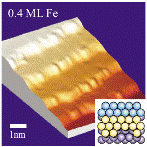Department of Physics and Astronomy: Publications and Other Research

Axel Enders Publications
Document Type
Article
Date of this Version
2012
Citation
Physical Chemistry Chemical Physics 14 (2012), pp. 4971-4976; doi: 10.1039/c2cp40254h
Abstract
Engineering the electronic structure of organics through interface manipulation, particularly the interface dipole and the barriers to charge carrier injection, is of essential importance to improve organic devices. This requires the meticulous fabrication of desired organic structures by precisely controlling the interactions between molecules. The well-known principles of organic coordination chemistry cannot be applied without proper consideration of extra molecular hybridization, charge transfer and dipole formation at the interfaces. Here we identify the interplay between energy level alignment, charge transfer, surface dipole and charge pillow effect and show how these effects collectively determine the net force between adsorbed porphyrin 2H-TPP on Cu(111). We show that the forces between supported porphyrins can be altered by controlling the amount of charge transferred across the interface accurately through the relative alignment of molecular electronic levels with respect to the Shockley surface state of the metal substrate, and hence govern the self-assembly of the molecules.
Includes Supplementary Materials.


Comments
Copyright © 2012 Royal Society of Chemistry. Used by permission.